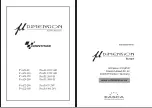
-5-
1. Location:
The circulator can be installed on the supply or return side of the water heater or heat
source. See Figures 2 & 3 on pages 3 and 4 for preferred locations.
2. Mounting Position:
Circulator must be mounted with the motor in the horizontal position.
See diagrams below for acceptable motor mounting orientations.
3. Flange Model:
Fasten circulator to system piping. The circulator flanges incorporate a
nut-grabber feature for easier installation.
CAUTION:
Do not use flat rubber gaskets. Only use O-ring gaskets provided
or leaks may result. Warranty will be voided.
4. Union Model:
Install the union tailpiece fitting set (sold separately) best suited for your
system piping. (See Union Fitting Options chart on the back cover). Install circulator by attaching
pump casing to each union tailpiece fitting. Tighten union nut onto circulator threading
(being careful not to overtighten) to complete the installation.
CAUTION:
Only use union gaskets provided with union fitting sets or leaks may result.
Warranty will be voided.
ACCEPTABLE MOTOR MOUNTING POSITIONS AND EASY CASING ROTATION
Integral Flow Check (IFC®) option — An IFC® is included in carton. If required, press IFC into the
machined discharge port with plunger and O-ring facing in, until it snaps into place. Before
installing, press IFC plunger to be sure it moves freely. See figures 4 & 5 above
5. Filling the system:
The system must be filled before operating the circulator. The bearings are
water lubricated and should not be allowed to operate dry. It is always good practice to flush
a new system of foreign matter before starting the circulator. See page 3 for recommended
air purging steps.
CAUTION
: To reduce the possibility of noise transmission, be sure to add vibration
dampeners to piping when mounting circulator to wall or floor joists.
ATTENTION
: Pour réduire la possibilité de transmission de bruit, veillez à ajouter des
amortisseurs de vibration à la tuyauterie lors du montage du circulateur sur des
chevêtres de mur ou de plancher.
WARNING:
Risk of electric shock. To reduce the risk of electric shock, be certain that it is
connected only to a properly grounded, grounding-type receptacle. Follow all local elec-
trical and plumbing codes.
AVERTISSEMENT:
Risque de choc électrique. Pour réduire le risque de choc électrique,
veillez à ce qu’elle soit raccordée uniquement àun réceptacle de type mise à la terre
proprement mis à la terre. Respectez tous les codes de plomberie et électriques locaux.
Always install with motor in
horizontal orientation. Position
electrical junction box at 9 o’clock
for best viewing orientation. Pump
casing may be rotated to change
flow direction. Locate the arrow
on the casing body to determine
flow direction.
To rotate the pump casing, remove the 4 motor screws.
When rotating
pump casing position, DO NOT detach motor housing from the
casing.
Damage to the casing O-ring and leakage may result. Simply spin
casing to the proper flow direction desired as shown in Figure 4 and
Figure 5. Reattach the 4 screws (1⁄8” allens wrench required). Be sure
motor is positioned correctly and is seated evenly to prevent leakage or
damage to O-ring. Tighten motor screws evenly to
25-38
in-lbs torque.
Spin
casing
to
change
flow
direction.
Figure 4
Figure 5
Figure 6
Spin casing
to change
flow direction.
Do not detach motor frame
from pump casing. Simply
spin casing to the proper
flow direction
Summary of Contents for 007e Series
Page 10: ... 10 NOTES ...
Page 11: ... 11 NOTES ...






























